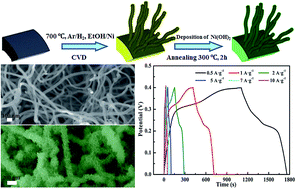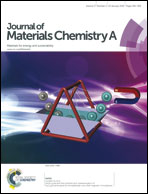In situ fabrication of three-dimensional, ultrathin graphite/carbon nanotube/NiO composite as binder-free electrode for high-performance energy storage†
Abstract
Metal oxides have attracted considerable attention as promising electrode materials for energy storage, but the use of metal oxides for electrodes still faces challenges such as attaining high capacity, good cycle stability, and high-rated performance. Therefore, rational design of electrode architectures and assembling metal oxides into desired structures to further enhance electrochemical performance is necessary. Here, novel 3D electrode architectures consisting of 3D ultra-thin graphite film (UGF)/carbon nanotubes (CNTs) uniformly covered by NiO nanosheets are successfully constructed by a chemical vapor deposition and subsequent electrodeposition, which are directly used as bind-free electrodes for supercapacitors and Li-ion batteries. In such composite structures, 3D UGF/CNTs serve as substrates for NiO nanosheet decoration, and act as spacers to stabilize the composite structure, making the active surfaces of NiO nanosheets accessible for electrolyte penetration and accommodating volume changes during charge/discharge processes. As expected, 3D UGF/CNTs/NiO as electrode material for supercapacitors showed high specific capacitance (750.8 F g−1 at current density of 1 A g−1), superior rate performance (capacitance of 575.6 F g−1 at 10 A g−1) and excellent cycle stability (no decay after 3000 cycles). Moreover, the 3D CNTs/UGF/NiO composite also exhibited enhanced lithium storage properties as anode materials for Li-ion batteries.


 Please wait while we load your content...
Please wait while we load your content...